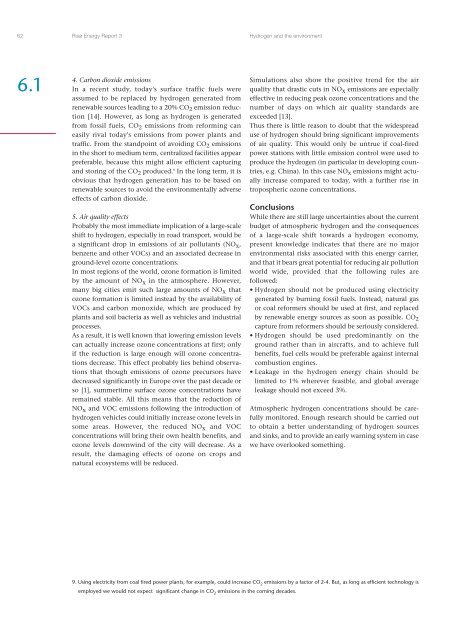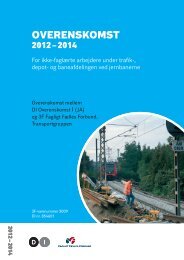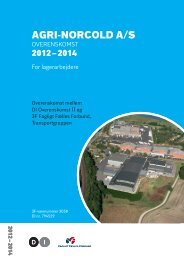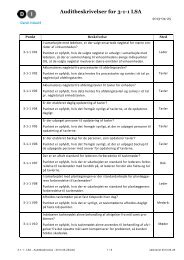62Risø Energy Report 3<strong>Hydrogen</strong> <strong>and</strong> the environment6.14. Carbon dioxide emissionsIn a recent study, today's surface traffic fuels wereassumed to be replaced by hydrogen generated fromrenewable sources leading to a 20% CO 2 emission reduction[14]. However, as long as hydrogen is generatedfrom fossil fuels, CO 2 emissions from reforming caneasily rival today's emissions from power plants <strong>and</strong>traffic. From the st<strong>and</strong>point of avoiding CO 2 emissionsin the short to medium term, centralized facilities appearpreferable, because this might allow efficient capturing<strong>and</strong> storing of the CO 2 produced. 9 In the long term, it isobvious that hydrogen generation has to be based onrenewable sources to avoid the environmentally adverseeffects of carbon dioxide.5. Air quality effectsProbably the most immediate implication of a large-scaleshift to hydrogen, especially in road transport, would bea significant drop in emissions of air pollutants (NO x ,benzene <strong>and</strong> other VOCs) <strong>and</strong> an associated decrease inground-level ozone concentrations.In most regions of the world, ozone formation is limitedby the amount of NO x in the atmosphere. However,many big cities emit such large amounts of NO x thatozone formation is limited instead by the availability ofVOCs <strong>and</strong> carbon monoxide, which are produced byplants <strong>and</strong> soil bacteria as well as vehicles <strong>and</strong> industrialprocesses.As a result, it is well known that lowering emission levelscan actually increase ozone concentrations at first; onlyif the reduction is large enough will ozone concentrationsdecrease. This effect probably lies behind observationsthat though emissions of ozone precursors havedecreased significantly in Europe over the past decade orso [1], summertime surface ozone concentrations haveremained stable. All this means that the reduction ofNO x <strong>and</strong> VOC emissions following the introduction ofhydrogen vehicles could initially increase ozone levels insome areas. However, the reduced NO x <strong>and</strong> VOCconcentrations will bring their own health benef<strong>its</strong>, <strong>and</strong>ozone levels downwind of the city will decrease. As aresult, the damaging effects of ozone on crops <strong>and</strong>natural ecosystems will be reduced.Simulations also show the positive trend for the airquality that drastic cuts in NO x emissions are especiallyeffective in reducing peak ozone concentrations <strong>and</strong> thenumber of days on which air quality st<strong>and</strong>ards areexceeded [13].Thus there is little reason to doubt that the widespreaduse of hydrogen should bring significant improvementsof air quality. This would only be untrue if coal-firedpower stations with little emission control were used toproduce the hydrogen (in particular in developing countries,e.g. China). In this case NO x emissions might actuallyincrease compared to today, with a further rise intropospheric ozone concentrations.ConclusionsWhile there are still large uncertainties about the currentbudget of atmospheric hydrogen <strong>and</strong> the consequencesof a large-scale shift towards a hydrogen economy,present knowledge indicates that there are no majorenvironmental risks associated with this energy carrier,<strong>and</strong> that it bears great potential for reducing air pollutionworld wide, provided that the following rules arefollowed:• <strong>Hydrogen</strong> should not be produced using electricitygenerated by burning fossil fuels. Instead, natural gasor coal reformers should be used at first, <strong>and</strong> replacedby renewable energy sources as soon as possible. CO 2capture from reformers should be seriously considered.• <strong>Hydrogen</strong> should be used predominantly on theground rather than in aircrafts, <strong>and</strong> to achieve fullbenef<strong>its</strong>, fuel cells would be preferable against internalcombustion engines.• Leakage in the hydrogen energy chain should belimited to 1% wherever feasible, <strong>and</strong> global averageleakage should not exceed 3%.Atmospheric hydrogen concentrations should be carefullymonitored. Enough research should be carried outto obtain a better underst<strong>and</strong>ing of hydrogen sources<strong>and</strong> sinks, <strong>and</strong> to provide an early warning system in casewe have overlooked something.9. Using electricity from coal fired power plants, for example, could increase CO 2 emissions by a factor of 2-4. But, as long as efficient technology isemployed we would not expect significant change in CO 2 emissions in the coming decades.
Risø Energy Report 3<strong>Hydrogen</strong> safety 636.2<strong>Hydrogen</strong> safetyNIJS JAN DUIJM, RISØ NATIONAL LABORATORY; LIONEL PERETTE, INERISSafety issues of hydrogen as an energycarrier<strong>Hydrogen</strong>'s extreme flammability implies safetyconcerns with <strong>its</strong> introduction as an energy carrier, especiallyin mobile applications such as cars. Many peoplerelate the hazards of hydrogen to the Hindenburg accident,but a more realistic scenario would be the accidentthat happened in Stockholm in 1983 (see box). Wouldthe intensive use of hydrogen by consumers result inmore, <strong>and</strong> more serious, accidents than the one in Stockholm?On Thursday 3 March 1983 a truck was delivering various industrialgases to sites in the Stockholm area. As a rack of argon gas cylinderswas being unloaded, hydrogen escaped from a rack of 18interconnected cylinders; each had a volume of 50 l <strong>and</strong> a workingpressure of 200 bar. Recent analysis estimates that the resultingexplosion involved about 4.5 kg of hydrogen. It injured 16 people,heavily damaged the facade of the nearest building, damaged tenvehicles <strong>and</strong> broke windows within a radius of 90 m [1].<strong>Hydrogen</strong> has some properties that make it moredangerous than conventional fuels such as gasoline, LPG(liquefied petroleum gas) <strong>and</strong> natural gas. <strong>Hydrogen</strong>'slower flammability limit in air is higher than that of LPGor gasoline, but <strong>its</strong> flammable range is very large (4-75%hydrogen in air). In the concentration range of 15-45%,the ignition energy of hydrogen is one-tenth than that ofgasoline. The “quenching gap” the smallest holethrough which a flame can propagate – is considerablysmaller for hydrogen than for the other fuels, whichmeans that the requirements for flame arrestors <strong>and</strong>similar equipment must be higher.<strong>Hydrogen</strong> has a number of other properties that mightcause hazardous situations if not properly accounted for,such as:• hydrogen is a strong reducing agent, <strong>and</strong> in contactwith metal oxides (rust) the resulting reaction canproduce heat;• hydrogen damages or is otherwise unsuitable for usewith many materials conventionally used for vessels,pipelines <strong>and</strong> fittings;• in contrast to other compressed gases, lowering thepressure of hydrogen increases <strong>its</strong> temperature (in engineeringterms, hydrogen has a negative Joule-Thomsoncoefficient at ambient temperature). When hydrogen isreleased from a high-pressure vessel, the resultingincrease in temperature can contribute to ignition;• hydrogen forms explosive mixtures with many othergases, including chlorine <strong>and</strong> other halogens;• hydrogen diffuses easily through many conventionalmaterials used for pipelines <strong>and</strong> vessels, <strong>and</strong> throughgaps that are small enough to seal other gases safely;<strong>and</strong>• the safety literature suggests that releases of hydrogenare more likely to cause explosions than releases ofmethane [2,3].In contrast to LPG <strong>and</strong> gasoline vapour, hydrogen isextremely light <strong>and</strong> rises rapidly in air. In the open thisis generally an advantage, but it can be dangerous inbuildings that are not designed for hydrogen. Manycountries' building codes, for instance, require garages tohave ventilation openings near the ground to removegasoline vapour, but there is often no high-level ventilation.<strong>Hydrogen</strong> released in such a building collects atroof level, <strong>and</strong> the resulting explosion can be extremelydestructive.<strong>Hydrogen</strong> has been used widely <strong>and</strong> on a large scale formore than a hundred years in a variety of industrialapplications. Of course there have been incidents withhydrogen, as there have been with other hazardousmaterials including gasoline, LPG <strong>and</strong> natural gas. Ingeneral, though, experience shows that hydrogen can beh<strong>and</strong>led safely in industrial applications as long as usersstick to the appropriate st<strong>and</strong>ards, regulations <strong>and</strong> bestpractices.But this experience does not cover the use of hydrogen atextremely high pressures (over 350 bar), as a cryogenicliquid <strong>and</strong> as hydrides – all technologies that are likely tobe required in a hydrogen economy. Most importantly,there is no precedent for the safe h<strong>and</strong>ling of hydrogenby people who have not received specific training to aprofessional st<strong>and</strong>ard. At present, hydrogen is h<strong>and</strong>ledin industries where operators receive training <strong>and</strong>instructions concerning safety, <strong>and</strong> hydrogen installationsare subject to professional safety management <strong>and</strong>inspection by safety authorities. It will be a challenge todevelop technologies <strong>and</strong> systems that can be used bygeneral consumers, where similar dedication to safety ishard to enforce.Regulations <strong>and</strong> st<strong>and</strong>ardsRegulations <strong>and</strong> st<strong>and</strong>ards help to ensure sound <strong>and</strong>consistent approaches to safety. They are thereforeimportant in promoting the safe use of hydrogen on awider scale.Regulations <strong>and</strong> st<strong>and</strong>ards have different purposes. Regulationsreflect legal constraints translated into safetyobjectives. They are set by governments, usually based
















